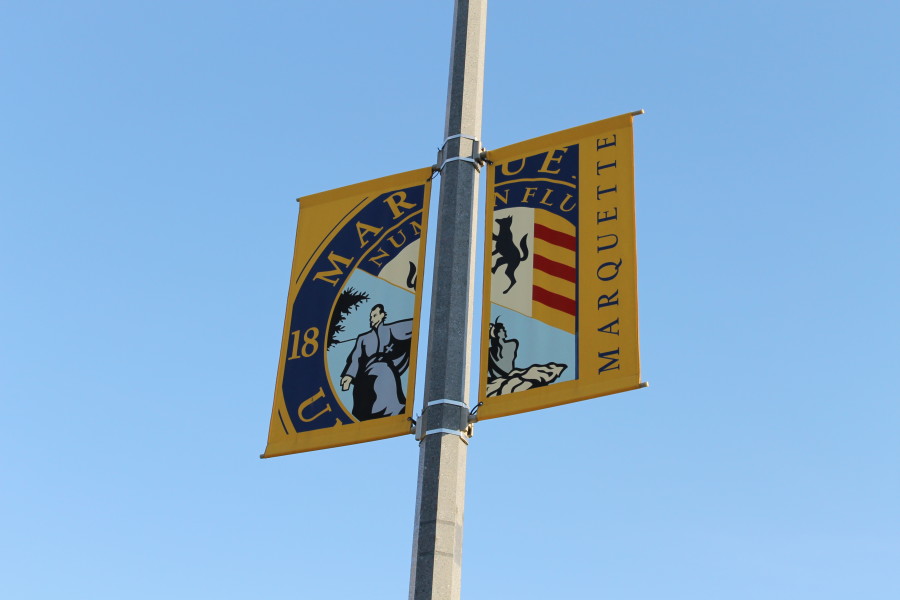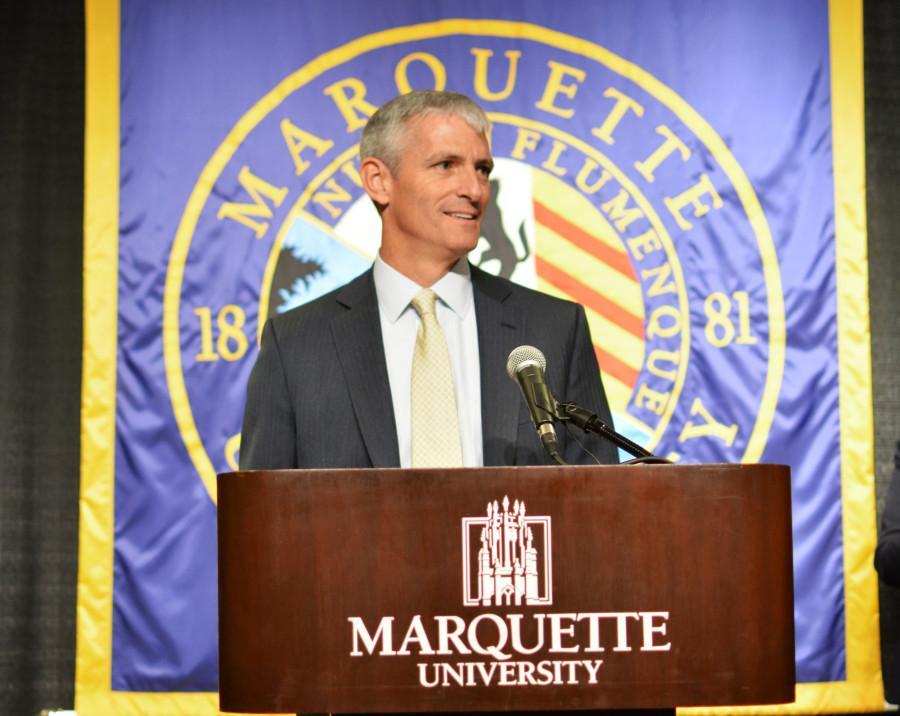
Think Milwaukee. What comes to mind? A cold mug of frothy Miller? Historic music venues? The winged art museum? Anthropomorphic sausage?
Or are you unsure?
That’s what VISIT Milwaukee, a tourism promotion organization, discovered in a report two years ago — people don’t know what to think about Milwaukee
As a member of the Common Council’s Community and Economic Development Committee, 13th District Alderman Terry Witkowski’s work often revolves around attracting new businesses to Milwaukee.
In the course of his work, he’s found people outside the city who had no concept of Milwaukee.
He’s even run into people who thought Milwaukee is in Minnesota.
“It’s hard to draw conventions and tourism to the city when you don’t know what the city has,” he said.
It’s for this reason that Witkowski has taken charge in the Common Council to establish a task force that will discuss how to project Milwaukee to the outside world.
Approved Feb. 9, the new board will consist of 24 members, including city and county officials and representatives from other economic development groups such as the Greater Milwaukee Committee and the Milwaukee Seven, Witkowski said. Members hope to hold the first board meeting within the next month, he said.
On the surface, the task force’s job is simple: determine a new civic identity for Milwaukee and create excitement among tourists and businesses considering Milwaukee as a destination.
“We need to have a reputation to enter the global economy,” Witkowski said.
For years, that reputation has revolved around “beer, brats, custard, fish fries and (the television show) Happy Days,” said Dave Fantle, vice president of public relations for VISIT Milwaukee.
And while there’s nothing wrong with that, Milwaukee also developed the character of a hard-working manufacturing town, not unlike Detroit or Cleveland, according to John Gurda, a local author and historian.
[youtube]wIVe-VKfoL4[/youtube]
Old Milwaukee: More than just beer
Milwaukee’s highest point of prominence came in the middle of the 20th century and had been building to that point since 1893. It was then that the Milwaukee-based Pabst Brewing Company won the beer competition at Chicago’s World’s Fair.
At this point, Milwaukee affirmed itself as “beer capital of the world,” Gurda said.
The city began earning this label following decades of German immigrants brewing their own beer in the 1800s, said Steve Byers, an assistant professor of journalism former beer industry reporter for the Milwaukee Journal. Eventually, these brewers began expanding and selling their products throughout the Midwest, which led to national recognition of Milwaukee’s brewing prowess, he said.
Brewers such as Pabst, Schlitz, Blatz and Miller continued to grow and employ thousands of Milwaukeeans through the 1950s, he said.
The beer industry was an important piece of Milwaukee’s economic puzzle, but other manufacturing industries played equally important roles in shaping Milwaukee during the 1900s, Gurda said.
“Milwaukee didn’t have a blue-collar reputation — it was reality,” he said.
Heavy manufacturing companies such as water heater manufacturer A. O. Smith, mining equipment producer Bucyrus, motorcycle builder Harley-Davidson, and many others employed about 56 percent of adult males in the city during the 1950s, Gurda said.
Milwaukee’s penchant for blue-collar work attracted more manufacturers and workers to the city and provided Milwaukee with national recognition as a major urban center, Gurda said.
This role as an urban center was further established when the Boston Braves moved to Milwaukee in 1953, he said. Led by future Hall-of-Famers Henry Aaron, Warren Spahn and Eddie Mathews, the Braves beat the mighty New York Yankees in the 1957 World Series.
The combination of a burgeoning manufacturing economy and the “unbridled joy” of World Series victory launched civic pride to new heights, Gurda said. In 1960, Milwaukee recorded its peak population of 741,324. In 2006, the census bureau estimated Milwaukee’s population at 573,358.
Milwaukee’s rise to prominence was impressive, but it wasn’t to last.
Urban areas across the country began thinning out as people began migrating to the suburbs. As more people left, manufacturing jobs also left for warmer Sun Belt climates, Gurda said. The beloved Braves acted as a microcosm of this exodus — they fled to Atlanta for the 1966 season and have been there ever since.
Even the breweries struggled.
Milwaukeeans began to have mixed feelings about living in the “beer capital of the world” because the breweries still used technology from the mid-1800s, Byers said.
“It created an image of oldness that stuck with Milwaukee for a long time,” Byers said.
Consolidation in the industry also began in the late 1950s as larger brewers began absorbing smaller ones, he said. Blatz became a Pabst brand in 1959 and Detroit brewer Stroh’s acquired the Schlitz name in 1982.
During the 1970s, Pabst ran into financial problems, which eventually led to the Milwaukee brewery’s closure in 1996. St. Louis-based Anheuser-Busch also expanded its production in the 1970s, which hurt Milwaukee’s beer industry, Byers said.
The city that claimed Pabst, Schlitz, Blatz and several other smaller breweries as its own found itself out of brewing assets. Milwaukee was back at square one, as the factories that the city hitched its proverbial wagon to all left town.
“It was not a good time,” Byers said.
New Milwaukee: Redressing its old style
Now, Milwaukee is working through a transition from former manufacturing giant to a viable member of the modern global economy.
“I like to say Milwaukee’s going from ‘Brew City’ to ‘New City,’” Fantle said.
Figuring out what to do with abandoned factories, neighborhoods and otherwise barren land in the inner city has been one of the struggles for Milwaukee during its current transition.
Redevelopment efforts at the Pabst brewery and in the Park East area, which include upscale condominiums, restaurants and movie theaters, are steps in the right direction, Gurda said.
“If people are expecting a Rust Belt city, they certainly don’t see that,” Witkowski said.
Visitors to Milwaukee are often surprised to see what the city has to offer, he said.
Much of Milwaukee’s attraction emanates from downtown, the East Side and the Third Ward. The Milwaukee Repertory Theater, the Pabst Theater, the Milwaukee Symphony Orchestra and the Milwaukee Art Museum overlooking Lake Michigan all provide a rich fine arts experience in the city, Gurda said.
“The art museum is symbolic of Milwaukee … like St. Louis’s arch or the Golden Gate Bridge in San Francisco,” Fantle said.
The museum is just one reason why the shore of Lake Michigan is important to Milwaukee.
“The city is showcasing the lakefront more proactively now than ever,” Fantle said.
Economically, the lake attracts businesses that use large quantities of water and water technology companies. The lake also allows for unique biological educational opportunities at the University of Wisconsin-Whitewater and the University of Wisconsin-Milwaukee, which plans to offer a graduate program in freshwater sciences, he said.
The Summerfest grounds, Veteran’s Park and Bradford Beach also provide prime leisure opportunities at the lakefront, he said.
Other outdoor attractions include the Wisconsin State Fair, the Milwaukee County Zoo and the rest of the county parks system, Fantle said.
“Milwaukee’s almost hyperactive during the summer months,” Gurda said.
The summer festivals were a key reason an August 2008 issue of Marie Claire magazine rated Milwaukee the sexiest city in America, beating out cities like Miami, New Orleans and Beijing.
The restaurant and nightlife scenes have also been growing in recent years, Gurda said.
These amenities have led more people to live in downtown apartments and condos. Prior to the economic downturn, Gurda said Milwaukee was adding approximately 500 downtown housing units per year.
Another important part of rebranding the city is introducing visitors to the new Milwaukee by drawing them in with its older allure, Fantle said. The two-year old Harley-Davidson museum, for example, represents a modern retelling of Milwaukee’s manufacturing tradition.
“People come to soak in the beer heritage, but leave surprised by the new city,” Fantle said.
Although many visitors are pleasantly surprised by Milwaukee, the task force must still work creatively to get the message out with only a small marketing budget.
This is why VISIT Milwaukee focuses on bringing conventions and business meetings to the city to generate word-of-mouth advertising, Fantle said.
Milwaukee leaders want to get the message out about the city’s transition.
Developing and delivering that message is the ultimate goal of the new task force, but since the group has yet to meet, they have a long way to go. Witkowski and Fantle are both hopeful positive steps will be taken towards manufacturing a new image for Milwaukee.
“We want everyone to believe in our destination,” Fantle said.





Edward • Feb 23, 2010 at 2:08 pm
Another thing that would help the city is more retention from Marquette: a vast majority of students here leave Milwaukee after school to return to Chicago/Minn. etc…